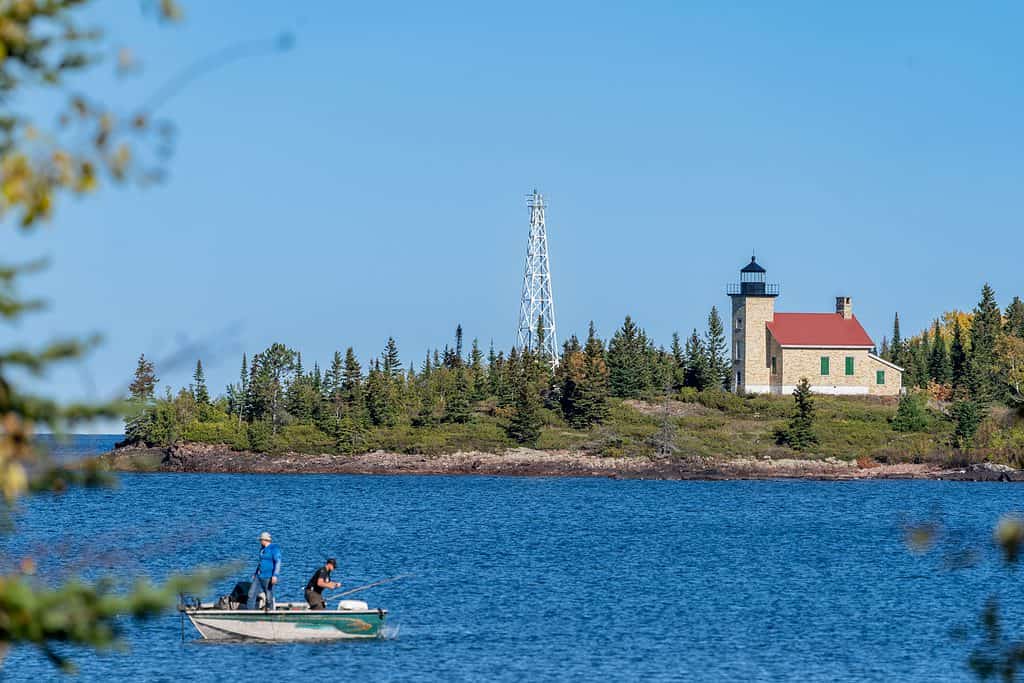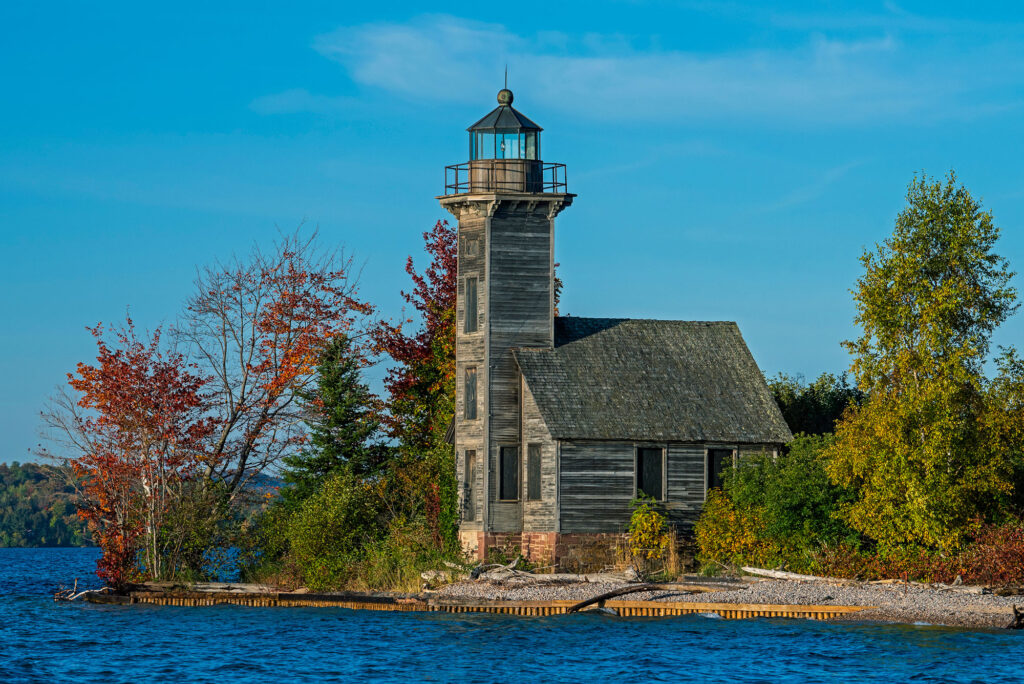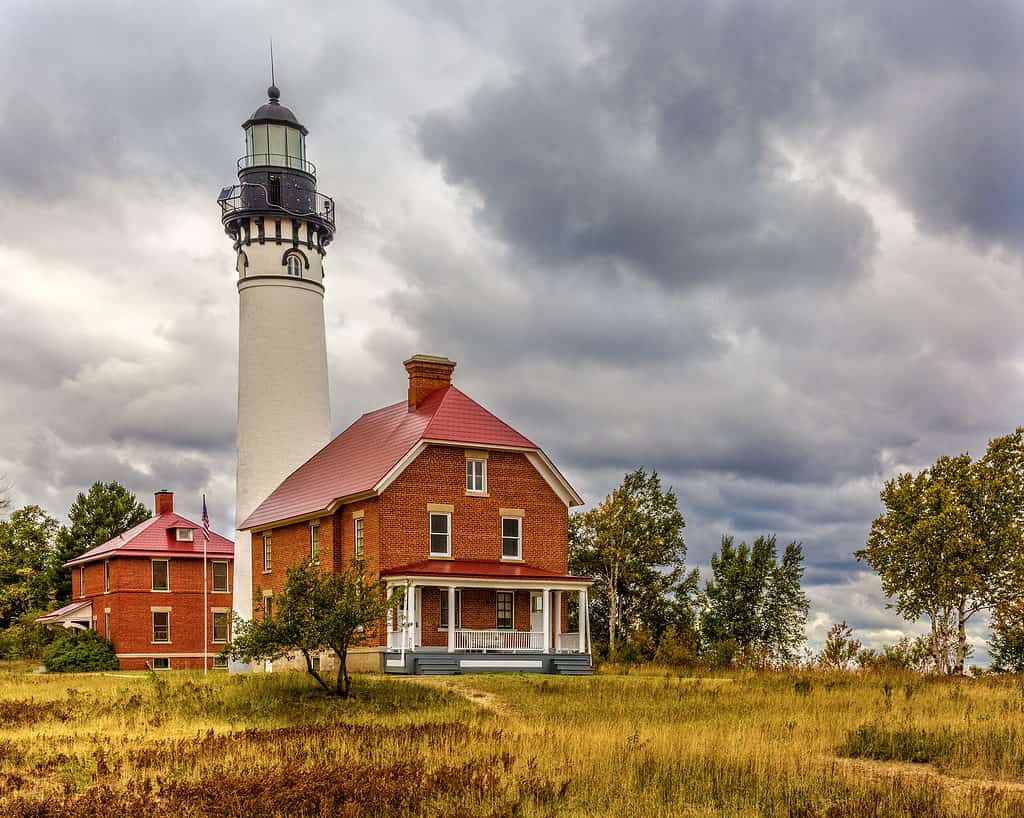Lake Superior, located on the Upper Peninsula of Michigan, is the world’s largest freshwater lake and home to more than 30 lighthouses. The lake is actually relatively young for a geological phenomenon, dating back roughly 10,000 years to the dawn of the Holocene period.

Lake Superior, Michigan, is the world’s largest freshwater lake, and home to more than 30 lighthouses.
©melissamn/Shutterstock.com
The Great Lakes of Michigan (Superior, Michigan, Huron, Erie, and Ontario) draw millions of tourists a year, renowned for their serene natural beauty and fantastic fishing. If you’re thinking about planning a trip to Michigan, you’ll want to take a look at our list! Read on to help plan your trip to some of Lake Superior’s most beautiful lighthouses.

1. Point Iroquois Lighthouse
The name “Point Iroquois” traces back to the Ojibwa tribe word for “Place of Iroquois Bones”. It memorializes a 1662 battle between the Ojibwa and the invading Iroquois.
Establishing the Lighthouse
The 65-foot tall Point Iroquois Lighthouse proudly stands at the crossroads of St. Mary’s River and Whitefish Bay, marking where Lake Superior meets its neighboring Great Lakes. In the mid-1800s, the Michigan state legislature directed its construction in Brimley, Michigan. Alongside twelve other lighthouses, the United States Congress approved its commission in January of 1853, setting aside $5000 for the project. By 1855, workers had erected the forty-five-foot stone tower and built a one-and-a-half-story residence for the lighthouse keeper. They also equipped the Point Iroquois Lighthouse with a Fresnel lens, amplifying its beam to stretch sixty-five feet across Lake Superior.
The Role of St. Mary’s Falls Canal
By 1844, with the thriving iron ore and copper trade, Michigan recognized the need for the St. Mary’s Falls Canal. This canal, aiding ships in transporting vital goods across the southern Great Lakes, opened in 1865. Since then, it has become the world’s most frequented canal for commercial shipping.
Evolution, Renovation, and Preservation
Over time, as shipments increased, the elements and constant use eroded the Point Iroquois Lighthouse. In response, the original tower and lighthouse keeper’s quarters underwent demolition. By 1870, builders had replaced them using durable brick, and this structure remains intact today.
After 107 years of manual oversight, an automated light in Gros Cap, Ontario, took over the lighthouse’s duties. In 1975, the lighthouse secured its place on the National Register of Historic Places. Nowadays, a volunteer-staffed museum informs visitors about the lighthouse and Lake Superior’s history, offering a bookshop and a detailed family photo album of past lighthouse keepers. The keeper’s residence now mirrors its appearance in the 1950s. For those seeking a breathtaking view of the lake and the shores of Michigan and Canada, 72 steps lead to the lighthouse’s summit.

The Point Iroquois Lighthouse and its keepers’ quarters, originally built in the mid-1800s, were rebuilt with sturdier materials in 1870.
©ehrlif/Shutterstock.com
2. Whitefish Point Lighthouse
Established in 1848, the Whitefish Point Lighthouse began its operations in 1849, marking it as Lake Superior‘s longest-standing lighthouse and one of its first. The notorious 80-mile coastline stretch, known as “Shipwreck Coast” or the “Graveyard of the Great Lakes,” has witnessed a significant number of vessels sinking between the Point and Munising, Michigan.
The Need for the Lighthouse
Whitefish Point accounted for nearly half of the 550 documented shipwrecks in this region, leading the United States Congress to initiate the Whitefish Point Lighthouse’s construction in 1849. The 1975 sinking of the SS Edmund Fitzgerald, which carried vast iron ore quantities, remains the most notable shipwreck. This tragedy claimed the lives of all twenty-nine crew members.
Transition in Management
The United States Lighthouse Service oversaw the Whitefish Point Lighthouse from its initial lighting until 1923. Following the construction of a Lifeboat Rescue Station at the point, the United States Coast Guard took over. By 1939, a merger had taken place, allowing both entities to jointly manage the location.
Upgrades and Reconstruction
In 1857, the lighthouse swapped its dated Winslow and Lewis reflector/lamp system for a Third Order Fresnel Lens. However, by 1861, Lake Superior’s relentless weather had compromised the lighthouse’s structural integrity. To counter this, steel became the chosen material for its reconstruction, offering resilience against potent wind and water forces.
Preservation and Museum Creation
The National Register of Historic Places listed the Whitefish Point Lighthouse in 1973, but restoration funds were initially unavailable. In 1980, Whitefish Township, partnering with the Great Lakes Shipwreck Historical Society, embarked on a mission to conserve the lighthouse. The Coast Guard then permitted the GLSHS to establish a museum, which opened to the public in 1985. Following an act passed by the United States Congress in October 1996, the Great Lakes Shipwreck Historical Society took over the lighthouse’s upkeep.

The Whitefish Point Lighthouse is the longest-running lighthouse on Lake Superior.
©ehrlif/Shutterstock.com
3. Grand Island East Channel Lighthouse
The Grand Island East Channel Lighthouse, also known as the Grand Island Harbor Lighthouse, stands uniquely on Lake Superior. Its location on the southern shore of Grand Island, just north of Munising, Michigan, and its distinct stone base paired with a church-like wooden exterior have made it one of Michigan’s most photographed lighthouses.
Funding and Construction
In 1866, the United States Congress raised its initial allocation from $6,000 to $16,000. Construction began in the summer of 1868, and by August 15th of the same year, the light from the tower shone forty-nine feet across Lake Michigan. To enhance its efficiency, a fifth-order Fresnel lens replaced the original steamers lens in 1869.
Role in Navigation
For nearly 50 years, the Grand Island East Channel Lighthouse guided ships from Lake Superior into the Munising harbor. During this period, six lighthouse keepers maintained its operations.
Decommission and Privatization
In 1905, after sanctioning the establishment of several long-range lights on the mainland, the local Lighthouse Board decommissioned the Grand Island East Channel Lighthouse. By 1913, the lighthouse ceased operations. In 1915, it, along with the surrounding land, found a new private owner. This owner permitted neighboring landowners to co-manage the lighthouse keepers’ quarters.
Current Sightseeing Opportunities
Nowadays, visitors can admire the tower and its quarters through boat tours provided by three Munising companies: Pictured Rocks tour, Grand Island Cruises, and Shipwreck tour. The establishment of the East Channel Lighthouse Rescue organization ensures the structure’s preservation, allowing tourists to appreciate its historical charm while navigating the canal.

Built in 1868, the Grand Island East Channel Lighthouse has become one of the most photographed lighthouses in Michigan.
©iStock.com/dpenn
4. Au Sable Point Lighthouse
The Au Sable Point Lighthouse, formerly known as the Big Sable Point Light Station, stands as one of Lake Michigan’s earliest lighthouses, a companion to the Whitefish Point Lighthouse. Situated on the northern tip of Grand Island within the Pictured Rocks National Lakeshore, builders erected this tower over two years with a $40,000 budget granted by Congress. Additionally, Michigan sold 326 acres of land to the federal government, contributing an extra $407. By August 19th, 1874, the construction culminated, with the first lighthouse keeper, Casper Kuhn, taking charge.
Structural Details and Additions
Reaching 86 feet high and delving an additional 23 feet into the bedrock, the Au Sable Point Lighthouse is an impressive structure. The complex not only features the main tower but also a fog signal building and a brick oil building (constructed in the 1890s), accompanied by the lighthouse keeper’s residence. The tower boasts a third-order Fresnel lens, casting its light more than 17 miles over the water.
In 1909, builders erected a separate building for the lighthouse keeper. The original structure underwent expansions to accommodate assistant lighthouse keepers and their families. This renovation included the addition of a second story with a separate entrance to ensure privacy.
Transition of Ownership
In 1945, post-World War II, the United States Coast Guard took over the lighthouse and its keeper’s quarters. They automated the lighthouse in 1958, removing the Fresnel lens after 84 years of manual operation. A decade later, the Coast Guard handed the lighthouse’s reins to the National Park Service.
Current Status and Accessibility
Today, the lighthouse operates on solar power. The previously removed third-order Fresnel lens remains on-site. For those eager to visit, a one-and-a-half-mile trail along Lake Superior’s edge leads to this remote beacon. Recognizing its historical significance, both the National Register of Historical Sites and the Michigan State Register of Historic Sites have listed the Au Sable Point Lighthouse.

The Au Sable Point Lighthouse was automated in 1958 after 84 years of manual operation.
©Jack R Perry Photography/Shutterstock.com
5. Big Bay Point Lighthouse
On February 15th, 1893, Congress commissioned the Big Bay Point Lighthouse and allocated $25,000 for its construction. In May 1896, after purchasing a five-acre plot of land, the state of Michigan started building the lighthouse. By October, the tower stood tall on a bluff overlooking Big Bay, Michigan.
Navigational Significance and Design
Equipped with a third-order Fresnel lens, the lighthouse became vital, especially since Big Bay Point had witnessed many shipwrecks. The point, situated between the Huron Islands and Granite Island, spans 18 miles of tumultuous waters frequently navigated by passenger steamships. Moreover, ships from Buffalo, Duluth, and Chicago regularly passed through, carrying goods to prominent destinations on Lake Superior’s southern fringes.
The architectural marvel comprises two stories, a duplex, eighteen rooms, and a lantern room/tower stretching beyond 60 feet. Perched on the bluff, the light beamed eighty-nine feet above Lake Superior.
In 1940, electrical power illuminated the premises, and by 1941, the last lighthouse keeper departed, marking the tower as unmonitored.
Military Use and Civilian Ownership
For a short time, the U.S. Army and National Guard leased the property for anti-aircraft exercises, pitching tents near the lighthouse for soldiers. Between 1961 and 1979, a plastic surgeon from Chicago, Jon Pick, owned the lighthouse. After two decades of renovation, which included transforming the duplex into a larger space, he sold it to Dan Hitchens in 1980. By 1985, Norman Gotschall had purchased it.
Haunted B&B Legacy
Despite eerie tales of haunting, Gotschall and his wife converted the Big Bay Point Lighthouse into a bed and breakfast in 1986. After changing hands twice more, in 1992 and 2018, Nick Korstad currently owns it, maintaining its status as a popular bed and breakfast.

Big Bay Point Lighthouse shone its light eighty-nine feet above Lake Superior thanks to its position on the bluff.
©Henryk Sadura/Shutterstock.com
The 5 Most Beautiful Lake Superior Lighthouses
| Rank | Lighthouse | Location |
|---|---|---|
| 1 | Point Iroquois Lighthouse | Brimley |
| 2 | Whitefish Point Lighthouse | Paradise |
| 3 | Grand Island East Channel Lighthouse | Southeast shore of Grand Island |
| 4 | Au Sable Point Lighthouse | South shore of Lake Superior |
| 5 | Big Bay Point Lighthouse | Big Bay |
The photo featured at the top of this post is © Doug Lemke/Shutterstock.com
Sources
- Lighthouse Friends, Available here: https://www.lighthousefriends.com/light.asp?ID=566
- USDA Forest Service, Available here: https://www.fs.usda.gov/recarea/hiawatha/recarea/?recid=13342
- Sault Ste. Marie Convention & Visitors Bureau, Available here: https://saultstemarie.com/attractions/point-iroquois-lighthouse/
- Pure Michigan, Available here: https://www.michigan.org/property/point-iroquois-lighthouse
- Great Lakes Shipwreck Museum, Available here: https://www.shipwreckmuseum.com/shipwreck-museum/whitefish-point-light/
- Exploring the North, Available here: https://www.exploringthenorth.com/whitefish/whitefish.html
- Lighthouse Friends, Available here: https://www.lighthousefriends.com/light.asp?ID=726
- Glass Bottom Shipwreck Tours, Available here: https://shipwrecktours.com/east-channel-lighthouse/
- Office of the Law Revision Counsel United States Code, Available here: https://uscode.house.gov/statutes/pl/104/324.pdf
- Explore Munising, Available here: https://www.exploremunising.com/lighthouses/
- Accidentally Wes Anderson, Available here: https://accidentallywesanderson.com/places/grand-island-east-channel-light/
- National Park Service, Available here: https://www.nps.gov/piro/learn/historyculture/ausablelightstation.htm
- Exploring the North, Available here: https://www.exploringthenorth.com/ausable/ausable.html
- Lighthouse Friends, Available here: https://www.lighthousefriends.com/light.asp?ID=574
Thank you for reading! Have some feedback for us? Contact the AZ Animals editorial team.






